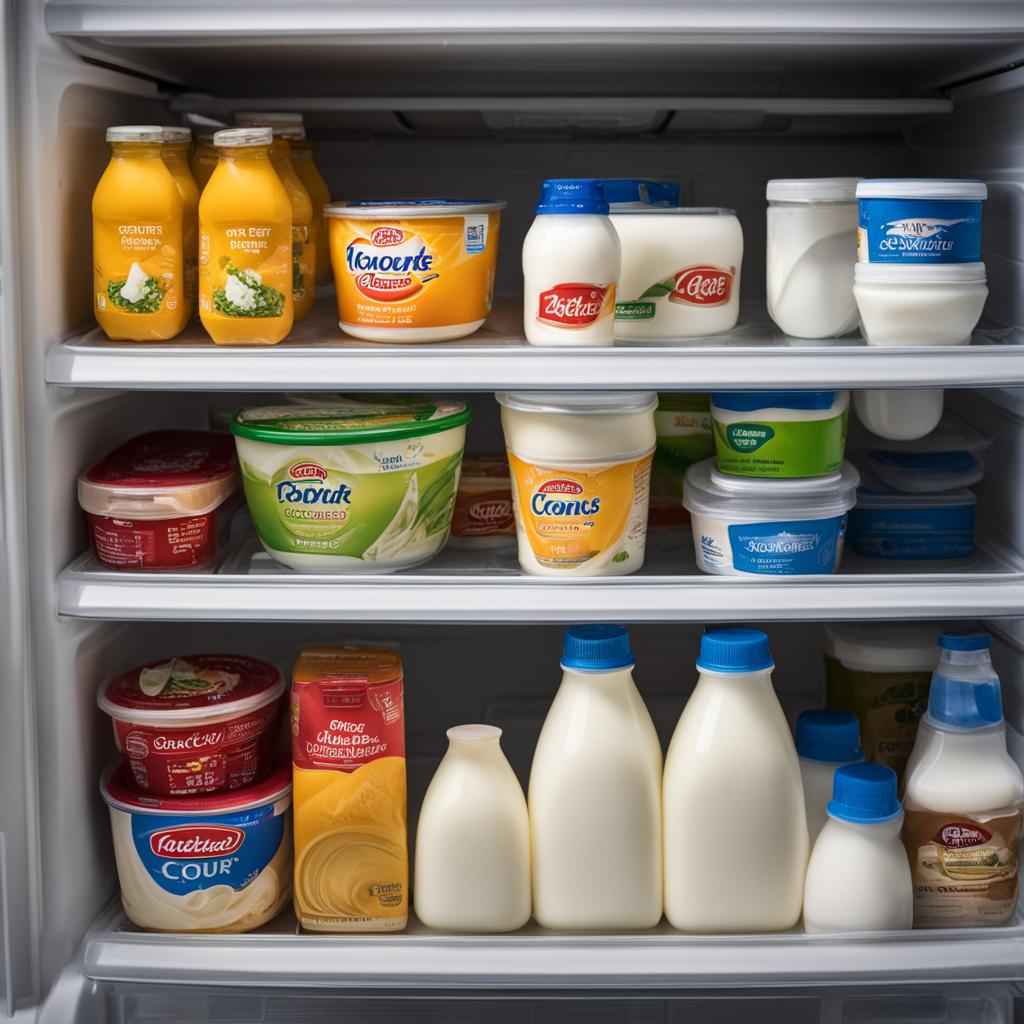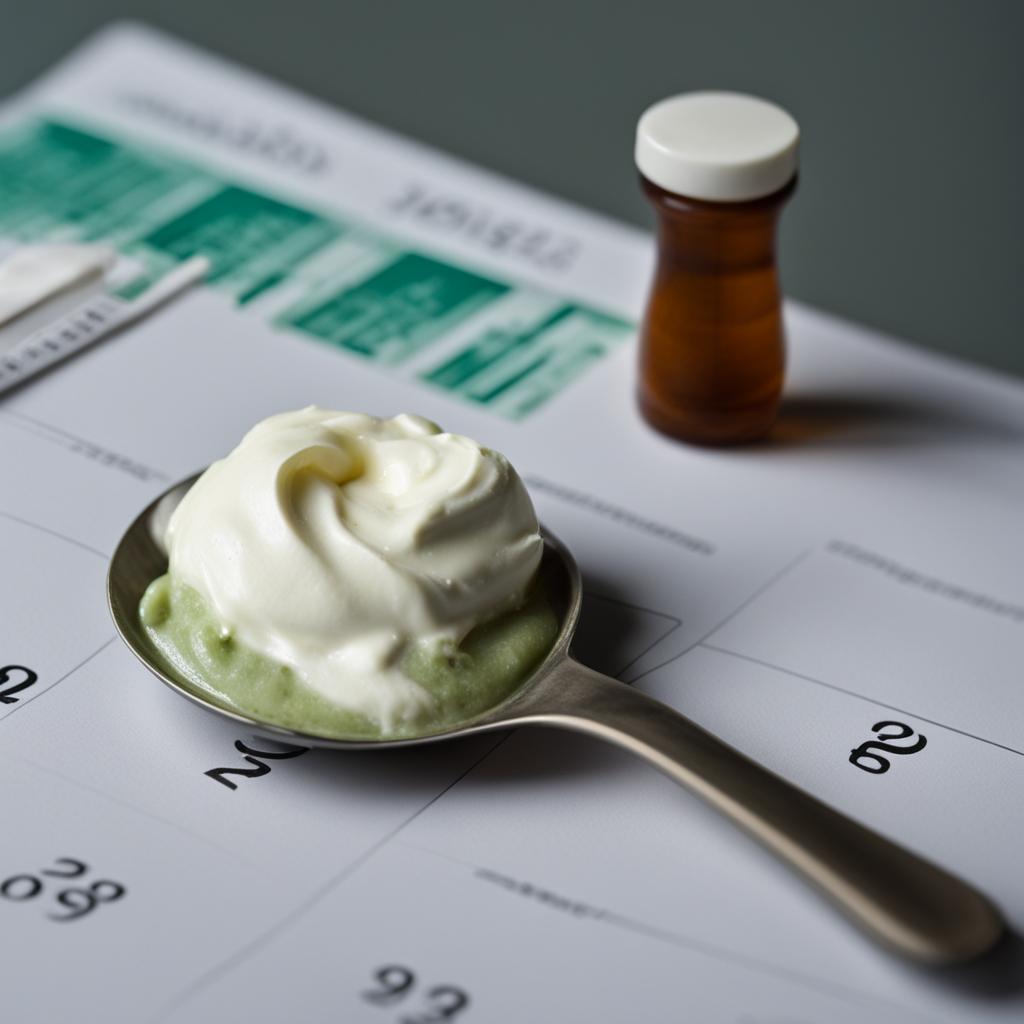As a sour cream lover, I always want to ensure that the dairy product I’m using is fresh and safe to consume. Knowing how to determine if sour cream has gone bad is essential to avoid any unpleasant surprises. In this article, I will guide you through a quality check process that will help you identify signs of spoilage in sour cream, ensuring you can enjoy it with peace of mind.
Key Takeaways:
- Perform a visual inspection for any mold, off-color, or discoloration in the sour cream.
- Check the texture for clumps or excessive wateriness, ensuring it has a smooth and creamy consistency.
- Trust your nose and detect any foul or rancid odors that indicate spoilage.
- Taste the sour cream for any bitter or unpleasant flavors, as it may be a sign of spoilage.
- Observe the color of the sour cream, as any yellowing or abnormal discoloration can be indicative of bacterial growth.
Now, let’s dive into the details of each quality check method to ensure the freshness of your sour cream!
How to Check the Texture of Sour Cream
When it comes to determining if sour cream is bad, checking the texture is an essential step. A quick visual and tactile examination can reveal signs of spoilage and help you decide whether it’s safe to consume. Here are the key factors to consider when assessing the texture of sour cream:
- Smooth and Creamy: Healthy sour cream should have a smooth and creamy consistency. It should spread easily and have a rich texture.
- Clumps: Check for any clumps or lumps in the sour cream. These can be a sign of spoilage and indicate bacterial growth.
- Excessive Wateriness: While a small amount of liquid separation (whey) is normal in sour cream, excessive watery texture may indicate that the cream has gone bad.
Remember that changes in texture can be an indication of spoilage, so trust your instincts and use caution when encountering an abnormal texture in sour cream.
“Smooth and creamy texture is a good indicator of the quality of sour cream.”
Table: Texture Assessment Guide
| Texture | Meaning | Action |
|---|---|---|
| Smooth and creamy | Good quality | No action required |
| Clumpy or lumpy | Spoiled | Discard |
| Excessively watery | Possible spoilage | Exercise caution |
By following these guidelines, you can confidently assess the texture of sour cream and make informed decisions regarding its freshness. Remember, it’s always better to be safe than sorry when it comes to consuming dairy products.
How to Identify Off Odor in Sour Cream
When it comes to sour cream, one of the key indicators of spoilage is the presence of an off odor. While sour cream naturally has a tangy smell, a foul or rancid odor is a clear sign that it has gone bad. Trust your nose and discard any sour cream that has an unpleasant smell.
As a rule of thumb, if the sour cream smells off or different from its usual tangy aroma, it is best to err on the side of caution and not consume it. The odor is often an indication of bacterial growth or other forms of spoilage.
I opened a container of sour cream and immediately noticed a strong rancid smell. I knew right away that it had spoiled and needed to be thrown away. Trust your senses when it comes to the smell of sour cream. If it doesn’t smell right, it’s best to play it safe and not eat it.
To ensure the freshness and safety of your sour cream, always give it a whiff before using it in your favorite recipes. By being mindful of the odor, you can avoid any potential health risks associated with consuming spoiled sour cream.
Table: Signs of Sour Cream Spoilage
| Signs of Spoilage | Description |
|---|---|
| Off odor | A foul or rancid smell, different from the usual tangy aroma |
| Visible mold | Presence of mold growth on the surface |
| Excessive wateriness | Texture becomes excessively watery, not creamy |
| Discoloration | Yellowing or other abnormal color changes |
| Unpleasant taste | Bitter or off-putting taste, different from the usual tangy flavor |
How to Test the Taste of Sour Cream
When it comes to determining the quality of sour cream, one important factor to consider is its taste. While sour cream naturally has a tangy flavor, it should not have any unpleasant or bitter taste. To ensure that your sour cream is not spoiled, follow these steps to test its taste:
- Start by taking a small spoonful of the sour cream.
- Allow it to sit on your tongue for a few seconds to experience the initial flavor.
- Take note of any unusual or off-putting taste that may indicate spoilage.
If the sour cream tastes sour, creamy, and fresh, it is likely still good to use. However, if you detect a bitter, sour taste, or any other unpleasant flavors, it is best to avoid consuming it as it may be spoiled.
Common Signs of Sour Cream Spoilage
In addition to testing the taste, it is essential to watch out for other signs of sour cream spoilage. These include:
- Visible mold
- Excessive wateriness
- Discoloration
- Off odor
If you notice any of these signs, it is strongly recommended to discard the sour cream as consuming spoiled dairy products can lead to food poisoning and other health risks.
| Signs of Spoiled Sour Cream | Quality Check |
|---|---|
| Visible mold | Discard |
| Excessive wateriness | Discard |
| Discoloration | Discard |
| Off odor | Discard |
| Unpleasant taste | Discard |
The Role of Color in Determining Sour Cream Freshness
When it comes to determining the freshness of sour cream, color plays a crucial role. The color of sour cream should be a creamy white, indicating its freshness and quality. Any noticeable deviations in color may be a sign of bacterial growth and spoilage.
Sour cream that has a yellowish tint or discoloration is likely to be past its prime. This discoloration can occur due to the presence of excess whey or the growth of bacteria. It is essential to remember that fresh sour cream should always maintain its pristine white color.
In some cases, you may notice small spots of mold on the surface of sour cream. This is a clear indication that the cream has gone bad and should be discarded immediately. Mold growth typically occurs due to improper storage or prolonged exposure to air.
Table: Visual Guide to Sour Cream Color and Freshness
| Color | Freshness | Spoiled |
|---|---|---|
| Creamy white | ✓ | ✕ |
| Yellowish tint | ✕ | ✓ |
| Mold spots | ✕ | ✓ |
By paying attention to the color of sour cream, you can quickly assess its freshness and decide whether it is safe to consume. Remember to trust your senses and discard any sour cream that shows signs of discoloration or mold, as this may pose health risks.
Understanding Expiration Dates on Sour Cream
When it comes to sour cream, understanding expiration dates is essential to ensure its freshness and quality. Expiration dates are typically indicated as sell-by dates, use-by dates, or best-by dates. While these dates provide guidance on the recommended period for consumption, they are not strict deadlines for safety.
So, what should you do if your sour cream is past the expiration date? Don’t worry just yet. Instead, conduct a quality check to determine if the sour cream is still good to eat. Look for signs of spoilage, such as mold, off-color, or an off smell. If the sour cream passes these checks, it is likely safe to consume, even if it is past the expiration date.
However, it’s important to note that sour cream should always be stored properly in the refrigerator at temperatures below 40°F to maintain its freshness for as long as possible. Leaving sour cream out at room temperature increases the risk of bacterial growth and spoilage, even before the expiration date. So, remember to keep your sour cream chilled to ensure its quality and safety.
| Expiration Date | Quality Check |
|---|---|
| Past date | Conduct a quality check for mold, off-color, or an off smell. If it passes the check, it is likely safe to consume. |
| Before date | Ensure proper refrigeration at temperatures below 40°F to prevent bacterial growth and spoilage. |
Remember, expiration dates on sour cream are just guidelines, and your senses are the ultimate judge. Trust your instincts and use the quality checks mentioned in this article to determine if your sour cream is still good to eat. By following proper storage practices and conducting regular quality checks, you can enjoy fresh and delicious sour cream for longer periods.
Proper Storage of Sour Cream
When it comes to preserving the freshness and quality of sour cream, proper storage is essential. By following the right storage practices, you can extend the shelf life and prevent spoilage. Here are some important tips for storing sour cream:
Avoid Leaving Sour Cream at Room Temperature
Sour cream should always be stored in the refrigerator at temperatures below 40°F (4°C). Leaving it out at room temperature can promote the growth of bacteria and lead to spoilage. Make sure to promptly return the sour cream to the fridge after each use to maintain its quality and safety.
Keep Sour Cream Sealed and Covered
To prevent the absorption of odors and the transfer of bacteria, it is crucial to keep the sour cream container tightly sealed and covered. Use the original packaging or transfer the sour cream to an airtight container before storing it in the refrigerator. This will help maintain its freshness and prevent cross-contamination.
Place Sour Cream in the Coolest Part of the Fridge
For optimal storage, position the sour cream in the coldest part of the refrigerator, such as the back or the lower shelves. This helps ensure that it stays consistently cold and free from temperature fluctuations. Avoid placing it in the fridge door, as it is subjected to frequent temperature changes when opened and closed.

Check the Expiration Date and Rotate Stock
Always check the expiration date of the sour cream before purchase and consumption. By adhering to the recommended date, you can ensure that you are consuming fresh and safe sour cream. Additionally, practice the “First In, First Out” (FIFO) method to rotate the stock in your fridge. Use the older containers of sour cream first before opening new ones to minimize waste and maximize freshness.
By following these proper storage practices, you can enjoy your sour cream for longer periods, maintain its quality, and reduce the risk of spoilage. Remember to always trust your senses and discard any sour cream that shows signs of spoilage, such as an off smell, visible mold, or unpleasant taste.
Importance of Food Safety and Quality Assurance
When it comes to sour cream, ensuring food safety and maintaining quality assurance are essential. Proper handling and storage practices play a vital role in preventing the consumption of spoiled sour cream, which can lead to foodborne illnesses and health risks. As a consumer, it’s important to be aware of these factors to make informed decisions about the sour cream you purchase and consume.
Food safety is a top priority in the production of commercially-produced sour cream. Manufacturers adhere to stringent quality control measures and safety standards to ensure the product is safe for consumption. These include regular testing for harmful bacteria, maintaining proper temperature control during production and transportation, and following strict hygiene practices.
However, it’s worth noting that homemade sour cream may introduce additional bacteria types and pose a higher risk for spoilage. The lack of quality assurance protocols and control measures in a home kitchen environment increases the likelihood of bacterial growth and the potential for sour cream to go bad more quickly.
By understanding the importance of food safety and quality assurance, you can make educated choices about the sour cream you consume. Always check for signs of spoilage such as an off odor, visible mold, excessive wateriness, discoloration, or an unpleasant taste. These indicators can help you avoid consuming sour cream that may pose health risks. Remember, when it comes to food safety, trust your senses and discard any sour cream that shows signs of spoilage.
Table: Commercially-produced Sour Cream vs. Homemade Sour Cream
| Factor | Commercially-produced Sour Cream | Homemade Sour Cream |
|---|---|---|
| Quality Control | Strict quality control measures ensure safety | Lack of quality assurance protocols |
| Bacterial Testing | Regular testing for harmful bacteria | No regular testing |
| Temperature Control | Maintained throughout production and transportation | Controlled within home kitchen environment |
| Hygiene Practices | Follows strict hygiene practices | Varies depending on individual |
| Risk of Spoilage | Lower risk due to stringent safety measures | Higher risk due to lack of control measures |
Common Signs of Sour Cream Spoilage
When it comes to sour cream, it’s important to be able to identify signs of spoilage. This will ensure that you consume only fresh and safe sour cream. Here are some common signs of sour cream spoilage to watch out for:
Off Smell:
One of the first indicators of spoiled sour cream is an unpleasant odor. If your sour cream has a foul or rancid smell, it is likely past its prime and should not be consumed. Trust your nose and discard any sour cream with an off smell.
Visible Mold:
Another clear sign of sour cream spoilage is the presence of visible mold. If you see any mold growth on the surface of the cream, it is best to discard the entire container. Mold can produce harmful toxins and consuming it can lead to foodborne illness.
Excessive Wateriness:
While some separation of liquid (whey) is normal in sour cream, excessive wateriness can be a sign of spoilage. If your sour cream has a watery texture or contains large clumps of liquid, it is likely no longer fresh. It’s best to err on the side of caution and dispose of it.
Discoloration:
Discoloration is another indication that your sour cream has spoiled. If you notice any yellowing or unusual color changes in the cream, it may be a sign of bacterial growth. Fresh sour cream should be white in color, so any discoloration should be taken as a warning sign.
Remember, these are just general guidelines for identifying sour cream spoilage. It’s always best to use your senses and trust your instincts when it comes to food safety. If in doubt, it’s better to be safe than sorry and discard any sour cream that shows signs of spoilage.
Table: Common Signs of Sour Cream Spoilage
| Signs of Spoilage | Description |
|---|---|
| Off Smell | Foul or rancid odor |
| Visible Mold | Mold growth on the surface |
| Excessive Wateriness | Watery texture or clumps of liquid |
| Discoloration | Yellowing or unusual color changes |
Risks of Consuming Spoiled Sour Cream
Consuming spoiled sour cream puts you at risk for food poisoning. The presence of harmful bacteria in spoiled sour cream can lead to gastrointestinal issues and other health risks. The most common symptoms of food poisoning from spoiled sour cream include stomach pains, nausea, diarrhea, or fever. It is important to be aware of these risks and take necessary precautions to avoid consuming spoiled sour cream.
Sour cream that has gone bad may contain pathogens such as Listeria, Salmonella, or E. coli, which can cause serious illness. These bacteria can multiply and thrive in a favorable environment, such as spoiled dairy products. Therefore, it is crucial to pay attention to the signs of spoilage mentioned earlier in this article and discard any sour cream that shows these signs.
To protect your health, it is best to prioritize food safety by checking the quality of your sour cream before consumption. This includes inspecting its texture, odor, taste, and color. If any of these indicators suggest spoilage, it is recommended to err on the side of caution and avoid consuming the sour cream to prevent potential health risks.

Key Takeaways:
- Consuming spoiled sour cream can result in food poisoning and various health risks.
- Symptoms of food poisoning caused by spoiled sour cream include stomach pains, nausea, diarrhea, or fever.
- Spoiled sour cream may contain harmful bacteria such as Listeria, Salmonella, or E. coli.
- It is important to prioritize food safety and discard any sour cream that shows signs of spoilage.
| Signs of Spoiled Sour Cream | Health Risks |
|---|---|
| Off smell | Food poisoning |
| Visible mold | Gastrointestinal issues |
| Excessive wateriness | Diarrhea |
| Discoloration | Stomach pains |
| Unpleasant taste | Nausea |
Can Sour Cream Be Frozen?
Many people wonder if it is possible to freeze sour cream to extend its shelf life. However, it is generally not recommended to freeze sour cream. Freezing can affect the texture and consistency of the cream, resulting in a watery or grainy texture upon thawing. It is best to use sour cream before it reaches its expiration date or shows signs of spoilage.
When sour cream is frozen and then thawed, the moisture in the cream can separate, leading to a curdled or watery consistency. This can negatively impact the quality and taste of the sour cream, making it less enjoyable to use in recipes or as a topping.
If you find yourself with extra sour cream that you won’t be able to use in time, consider finding alternative uses for it, such as incorporating it into dips, dressings, or baked goods.
Remember to always check the expiration date and perform a quality check before using any sour cream. It is important to prioritize food safety and ensure the freshness of your ingredients.
Sour Cream Storage Tips:
- Store sour cream in the refrigerator at temperatures below 40°F.
- Keep sour cream tightly sealed to prevent exposure to air and potential contamination.
- Place sour cream on a shelf away from strong-smelling foods to prevent flavor absorption.
- Never leave sour cream out at room temperature for an extended period of time.
- Always discard sour cream that shows signs of spoilage.
By following these storage tips and avoiding freezing, you can enjoy fresh and delicious sour cream for all your culinary creations.
Importance of Refrigeration for Sour Cream
When it comes to preserving the freshness and quality of sour cream, proper refrigeration is of utmost importance. Refrigeration plays a crucial role in preventing bacterial growth and spoilage, ensuring that your sour cream remains safe for consumption.
Storing sour cream in the refrigerator at temperatures below 40°F helps maintain its taste, texture, and overall quality. This cool environment slows down the growth of bacteria, extending the shelf life of the cream. Leaving sour cream out at room temperature for extended periods can lead to the multiplication of harmful bacteria, increasing the risk of spoilage and foodborne illnesses.
Refrigeration also helps preserve the smooth and creamy texture of sour cream. When sour cream is exposed to higher temperatures, it becomes prone to separation and watery consistency. By storing it in the refrigerator, you can ensure that the cream retains its desired texture and remains enjoyable to consume.
In summary, refrigeration is vital for maintaining the freshness, safety, and quality of sour cream. By storing it at the appropriate temperatures, you can prevent bacterial growth, prolong its shelf life, and preserve its smooth texture. Remember to always check for signs of spoilage, such as off odors, unusual discoloration, or an unpleasant taste, before consuming sour cream.
Conclusion
In conclusion, ensuring the quality of sour cream is essential for maintaining food safety. By performing a quick quality check, you can determine if your sour cream is still fresh and safe to consume. Pay attention to any signs of spoilage such as mold, off odor, watery texture, or unpleasant taste. These indicators can help you avoid the risks of consuming bad sour cream and potential food poisoning.
Remember to store your sour cream properly in the refrigerator, keeping it at temperatures below 40°F. This will help prevent bacterial growth and prolong its shelf life. Additionally, always check the expiration dates on the packaging and use sour cream before it reaches its recommended date. By following these simple steps, you can ensure the quality and safety of your sour cream.
Maintaining food safety is crucial, and by being mindful of the quality of our sour cream, we can protect ourselves and our loved ones from potential health risks. Regularly performing a quality check and practicing proper storage can go a long way in ensuring that the sour cream we consume is fresh, delicious, and safe.
FAQ
How can I tell if sour cream is bad?
Inspect the sour cream for mold, off-color, or an off smell. Check the texture for clumps or excessive wateriness. Taste the sour cream for any bitter or unpleasant flavors. Look for yellowing or discoloration in the cream.
What should the texture of sour cream be like?
Sour cream should have a smooth and creamy texture. Some separation of liquid (whey) is normal, but if the texture is lumpy or excessively watery, it may be a sign of spoilage.
How can I identify off odor in sour cream?
A normal sour cream smell is tangy. However, if you detect a foul or rancid odor, it is likely spoiled and should not be consumed.
How can I test the taste of sour cream?
Sour cream should taste tangy as it should. If it has a bitter or unpleasant taste, it has likely spoiled and should not be consumed.
What role does color play in determining sour cream freshness?
Sour cream should be white in color. If you notice any yellowing or discoloration, it may be an indication of bacterial growth and spoilage.
How should I understand expiration dates on sour cream?
Sour cream typically has a sell-by date, use-by date, or best-by date. These dates indicate the recommended period for consumption. If the sour cream is past the date, it may still be safe to consume if it passes the quality checks mentioned above.
How should sour cream be stored?
Sour cream should be stored in the refrigerator at temperatures below 40°F to maximize shelf life and prevent bacterial growth. Leaving sour cream out at room temperature increases the risk of spoilage.
Why is food safety and quality assurance important for sour cream?
Adhering to food safety practices and quality assurance standards is crucial in preventing the consumption of spoiled sour cream. Commercially-produced sour cream must adhere to safety standards, while homemade sour cream may introduce additional bacteria types.
What are common signs of sour cream spoilage?
Common signs of sour cream spoilage include an off smell, visible mold, excessive wateriness, discoloration, and an unpleasant taste. Trust your senses and discard any sour cream that shows these signs.
What are the risks of consuming spoiled sour cream?
Consuming spoiled sour cream puts you at risk for food poisoning. Symptoms may include stomach pains, nausea, diarrhea, or fever. It is best to avoid consuming sour cream that shows signs of spoilage.
Can sour cream be frozen?
Freezing sour cream is not recommended as it may affect the texture and consistency of the cream. It is best to use sour cream before it reaches its expiration date or shows signs of spoilage.
Why is refrigeration important for sour cream?
Sour cream should always be stored in the refrigerator at temperatures below 40°F to prevent bacterial growth. Leaving sour cream out at room temperature increases the risk of spoilage.
Source Links
- https://homecookbasics.com/how-to-tell-if-sour-cream-is-bad/
- https://www.thespruceeats.com/how-long-is-sour-cream-still-good-to-eat-1388306
- https://www.tastingtable.com/909486/how-to-tell-if-sour-cream-has-gone-bad/
Related Recipes:
 How to Identify Spoiled Canned Foods
How to Identify Spoiled Canned Foods
 How to Tell if Cheese is Bad: A Comprehensive Guide
How to Tell if Cheese is Bad: A Comprehensive Guide
 How to Tell if Strawberries Are Bad: Freshness Guide
How to Tell if Strawberries Are Bad: Freshness Guide
 How Long Can Yogurt Sit Out? Guidelines and Safety
How Long Can Yogurt Sit Out? Guidelines and Safety
 How to Tell if Jelly Has Gone Bad: Preserving Quality
How to Tell if Jelly Has Gone Bad: Preserving Quality
 How to Tell if Steak is Bad: Ensuring Quality
How to Tell if Steak is Bad: Ensuring Quality
 Freezing Sour Cream: What You Need to Know
Freezing Sour Cream: What You Need to Know
 How to Tell if Shredded Cheese is Bad: Storage Tips
How to Tell if Shredded Cheese is Bad: Storage Tips








